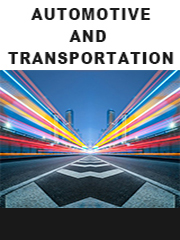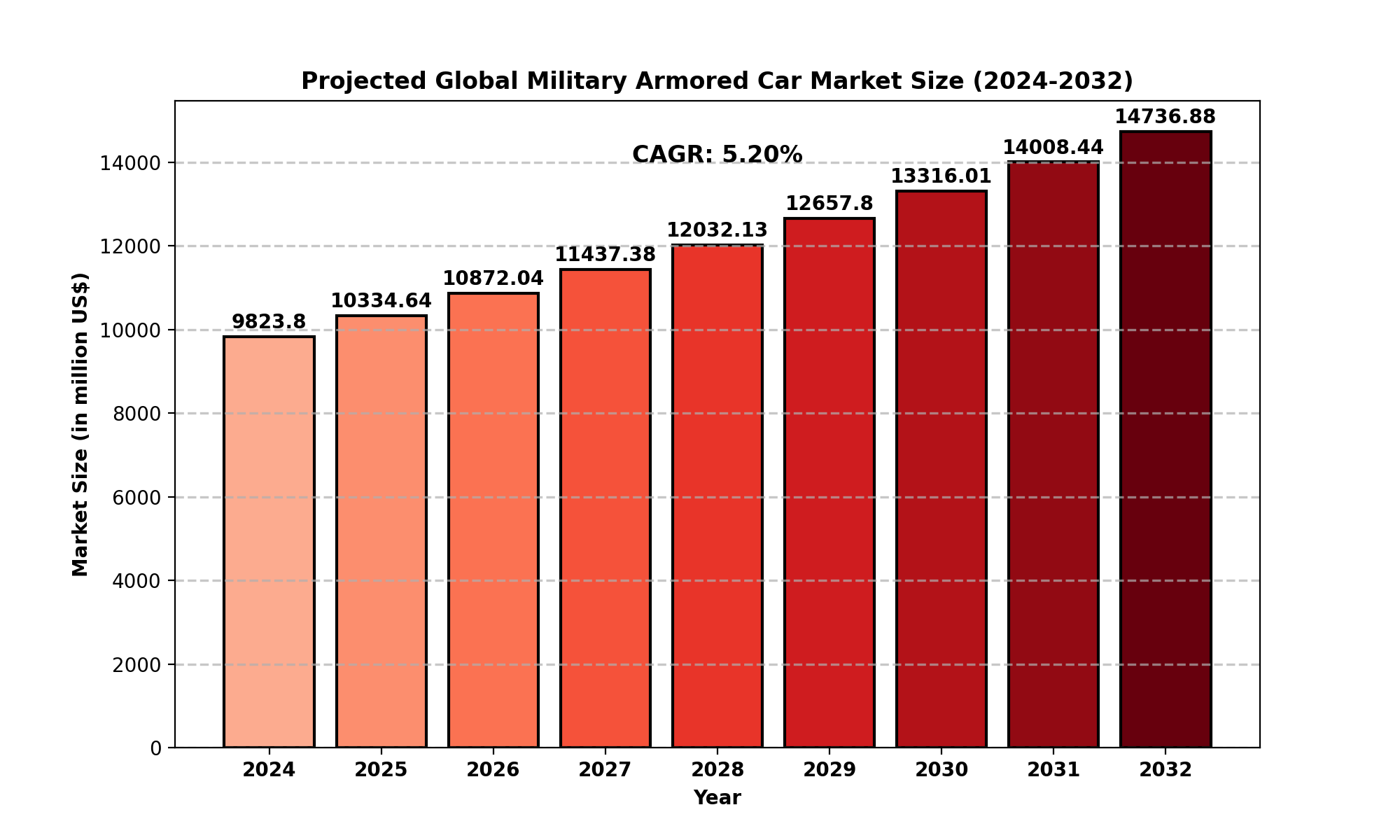TOP CATEGORY: Chemicals & Materials | Life Sciences | Banking & Finance | ICT Media

Download Report PDF Instantly
Report overview
A Military Armored Car is a specialized combat vehicle designed to provide superior protection and tactical mobility in hostile environments. These vehicles are essential in modern warfare, offering enhanced defense for military personnel against a wide range of threats, such as ballistic attacks, explosive devices, and shrapnel. Military armored cars are equipped with bulletproof windows, armored plating, and advanced surveillance and communication systems. They play a crucial role in reconnaissance missions, security patrols, and troop transport in dangerous combat zones, ensuring the safety of soldiers while maintaining operational mobility.
The global Military Armored Car market was valued at approximately USD 9.82 billion in 2024 and is projected to reach USD 14.73 billion by 2032, reflecting a compound annual growth rate (CAGR) of 5.20% during the forecast period.
This growth is driven by increasing defense expenditures worldwide and the rising demand for protection solutions in both military and homeland security applications. As countries enhance their defense capabilities and face escalating geopolitical tensions, the need for such armored vehicles will continue to rise.

Drivers
The market for military armored cars is primarily driven by several key factors:
Rising Security Concerns: With the growing prevalence of terrorist threats and armed conflicts, there is an increasing need for armored vehicles that can protect soldiers, VIPs, and critical infrastructure.
Defense Budget Increases: Many nations are increasing their defense spending to modernize military equipment, which includes acquiring more advanced armored vehicles.
Technological Advancements: Integration of cutting-edge technologies like autonomous driving systems, AI-powered surveillance, and improved armor materials are enhancing the efficiency and effectiveness of armored cars.
International Defense Collaborations: The expanding network of defense collaborations and agreements between countries is boosting demand for armored military vehicles.
Restraints
Despite the market’s growth, several challenges could hinder its expansion:
High Costs: The high production and maintenance costs of armored vehicles make them expensive investments for governments, especially in countries with limited defense budgets.
Regulatory Hurdles: Stringent regulations regarding the manufacture and export of military vehicles, especially to politically sensitive regions, could slow market growth.
Geopolitical Instability: While demand increases in conflict zones, certain regions experience fluctuations in political stability, which could affect procurement decisions.
Opportunities
There are significant opportunities for growth in the following areas:
Emerging Markets: Countries in Asia-Pacific, the Middle East, and Africa are seeing rising demand for military armored cars as their defense budgets grow due to regional security threats.
Upgrades and Retrofit Services: Many existing armored vehicles require upgrades, such as improved armor and enhanced surveillance systems, presenting opportunities for defense contractors to offer retrofit services.
Non-Defense Applications: Armored vehicles are increasingly being used in homeland security, law enforcement, and even commercial applications, expanding the market beyond traditional military uses.
Challenges
The military armored car market faces several ongoing challenges:
Sustainability and Environmental Concerns: The manufacturing of armored vehicles is energy-intensive and could face increasing pressure to adopt more environmentally friendly materials and processes.
Cybersecurity Threats: As armored vehicles integrate more digital systems, they become more vulnerable to cyberattacks, creating a need for enhanced cybersecurity measures.
Maintenance and Logistics: Given their complexity and the harsh environments in which they are used, armored vehicles require extensive maintenance and logistics support, adding to operational costs.
The market dynamics vary across different geographic regions, with some regions showing more robust demand for military armored cars than others.
North America: The North American market is the largest, with the U.S. contributing significantly to the demand. The U.S. military’s substantial defense budget, combined with geopolitical instability in various regions, has driven up demand for armored vehicles. The region is expected to maintain steady growth, with a CAGR of 4.46% through 2032.
Europe: Europe is experiencing a stable demand for military armored cars, primarily from countries like France, Germany, and the U.K., which continue to modernize their defense fleets in response to the evolving security situation in Eastern Europe.
Asia-Pacific: The Asia-Pacific region is expected to experience the highest growth rate during the forecast period, driven by military modernization programs in countries like India, China, and Japan.
South America: While demand remains relatively modest, increasing security concerns and defense investments in countries like Brazil may contribute to gradual market growth.
Middle East and Africa: This region continues to face high demand due to ongoing conflicts and terrorism-related threats, which are expected to keep the military armored car market active.
The global military armored car market is highly competitive, with several prominent companies dominating the space. These companies offer a wide range of armored vehicles for various military and security needs, focusing on quality, innovation, and advanced protection technologies. Some of the key players in the market include:
STREIT Group: Known for its extensive range of armored vehicles, STREIT Group has a strong presence across North America, Europe, and Asia.
Centigon Security Group: Centigon is a leading manufacturer of armored vehicles, specializing in custom-built solutions for military and civilian applications.
INKAS: INKAS is a renowned provider of high-end armored vehicles, including SUVs and specialized military cars.
Armormax: A major player in the armored car market, Armormax offers vehicle armoring services with cutting-edge technology.
DIMA HOLDINGS Co. Ltd: DIMA is recognized for its armored car manufacturing and armoring services, catering to both military and commercial sectors.
This report provides a deep insight into the global Military Armored Car market, covering all its essential aspects. This ranges from a macro overview of the market to micro details of the market size, competitive landscape, development trend, niche market, key market drivers and challenges, SWOT analysis, value chain analysis, etc.
The analysis helps the reader to shape the competition within the industries and strategies for the competitive environment to enhance the potential profit. Furthermore, it provides a simple framework for evaluating and assessing the position of the business organization. The report structure also focuses on the competitive landscape of the Global Military Armored Car market. This report introduces in detail the market share, market performance, product situation, operation situation, etc., of the main players, which helps the readers in the industry to identify the main competitors and deeply understand the competition pattern of the market.
In a word, this report is a must-read for industry players, investors, researchers, consultants, business strategists, and all those who have any kind of stake or are planning to foray into the Military Armored Car market in any manner.
Defense: The largest application for military armored cars, focusing on troop protection, security patrols, and battlefield reconnaissance.
Homeland Security: Armored vehicles are increasingly being deployed for domestic security, anti-terrorism efforts, and law enforcement protection.
B4
B5
B6
B7
STREIT Group
Centigon Security Group
INKAS
Armormax
DIMA HOLDINGS Co. Ltd
MSPV
Double Star (Shanghai)
JANKEL ARMOURING
The Armored Group
Shell Armored Vehicles
Alpine Armoring Inc
WELP Armouring
JCBL Armouring Solutions
North America (USA, Canada, Mexico)
Europe (Germany, UK, France, Russia, Italy, Rest of Europe)
Asia-Pacific (China, Japan, South Korea, India, Southeast Asia, Rest of Asia-Pacific)
South America (Brazil, Argentina, Columbia, Rest of South America)
The Middle East and Africa (Saudi Arabia, UAE, Egypt, Nigeria, South Africa, Rest of MEA)
What is the current market size of the Military Armored Car market?
Which are the key companies operating in the Military Armored Car market?
What are the key growth drivers in the Military Armored Car market?
Which regions dominate the Military Armored Car market?
What are the emerging trends in the Military Armored Car market?